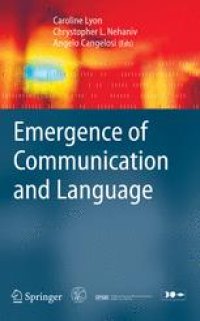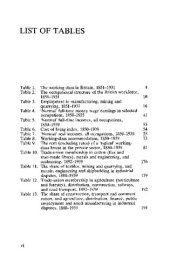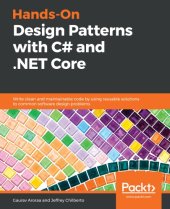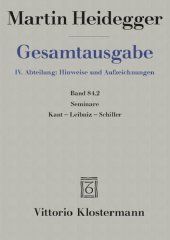
Ebook: Emergence of Communication and Language
- Tags: Language Translation and Linguistics, Artificial Intelligence (incl. Robotics), Simulation and Modeling, Computer Appl. in Social and Behavioral Sciences, Computer Appl. in Arts and Humanities
- Year: 2007
- Publisher: Springer-Verlag London
- Edition: 1
- Language: English
- pdf
Old questions on the origins of language and communication are illuminated here in new, state-of-the-art research.
This volume brings together studies from diverse disciplines, showing how they can inform and stimulate each other. It includes work in linguistics, psychology, neuroscience, anthropology and computer science. New empirical work is reported on both human and animal communication, using some novel techniques that have only recently become viable.
A principal theme is the importance of studies involving artificial agents, their contribution to the body of knowledge on the emergence of communication and language, and the role of simulations in exploring some of the most significant issues. A number of different synthetic systems are described, demonstrating how communication can emerge in natural and artificial organisms. Theories on the origins of language are supported by computational and robotic experiments.
Worldwide contributors to this volume include some of the most influential figures in the field, delivering essential reading for researchers and graduates in the area, as well as providing fascinating insights for a wider readership.
Caroline Lyon is a Senior Lecturer in Computer Science at the University of Hertfordshire. Her research and publications include work on the evolution of language, speech recognition, applications of neural networks and textual analysis. Chrystopher L. Nehaniv is Research Professor of Mathematical and Evolutionary Computer Science at the University of Hertfordshire and Director of the U.K. Engineering and Physical Sciences Research Council Network on Evolvability in Biological and Software Systems. Angelo Cangelosi is Professor in Artificial Intelligence and Cognition at the University of Plymouth. He is the editor of Simulating the Evolution of Language (Springer, 2002).
Old questions on the origins of language and communication are illuminated here in new, state-of-the-art research.
This volume brings together studies from diverse disciplines, showing how they can inform and stimulate each other. It includes work in linguistics, psychology, neuroscience, anthropology and computer science. New empirical work is reported on both human and animal communication, using some novel techniques that have only recently become viable.
A principal theme is the importance of studies involving artificial agents, their contribution to the body of knowledge on the emergence of communication and language, and the role of simulations in exploring some of the most significant issues. A number of different synthetic systems are described, demonstrating how communication can emerge in natural and artificial organisms. Theories on the origins of language are supported by computational and robotic experiments.
Worldwide contributors to this volume include some of the most influential figures in the field, delivering essential reading for researchers and graduates in the area, as well as providing fascinating insights for a wider readership.
Caroline Lyon is a Senior Lecturer in Computer Science at the University of Hertfordshire. Her research and publications include work on the evolution of language, speech recognition, applications of neural networks and textual analysis. Chrystopher L. Nehaniv is Research Professor of Mathematical and Evolutionary Computer Science at the University of Hertfordshire and Director of the U.K. Engineering and Physical Sciences Research Council Network on Evolvability in Biological and Software Systems. Angelo Cangelosi is Professor in Artificial Intelligence and Cognition at the University of Plymouth. He is the editor of Simulating the Evolution of Language (Springer, 2002).
Old questions on the origins of language and communication are illuminated here in new, state-of-the-art research.
This volume brings together studies from diverse disciplines, showing how they can inform and stimulate each other. It includes work in linguistics, psychology, neuroscience, anthropology and computer science. New empirical work is reported on both human and animal communication, using some novel techniques that have only recently become viable.
A principal theme is the importance of studies involving artificial agents, their contribution to the body of knowledge on the emergence of communication and language, and the role of simulations in exploring some of the most significant issues. A number of different synthetic systems are described, demonstrating how communication can emerge in natural and artificial organisms. Theories on the origins of language are supported by computational and robotic experiments.
Worldwide contributors to this volume include some of the most influential figures in the field, delivering essential reading for researchers and graduates in the area, as well as providing fascinating insights for a wider readership.
Caroline Lyon is a Senior Lecturer in Computer Science at the University of Hertfordshire. Her research and publications include work on the evolution of language, speech recognition, applications of neural networks and textual analysis. Chrystopher L. Nehaniv is Research Professor of Mathematical and Evolutionary Computer Science at the University of Hertfordshire and Director of the U.K. Engineering and Physical Sciences Research Council Network on Evolvability in Biological and Software Systems. Angelo Cangelosi is Professor in Artificial Intelligence and Cognition at the University of Plymouth. He is the editor of Simulating the Evolution of Language (Springer, 2002).
Content:
Front Matter....Pages i-xI
Front Matter....Pages 1-1
Introduction....Pages 1-27
Front Matter....Pages 28-28
Evolving Meaning: The Roles of Kin Selection, Allomothering and Paternal Care in Language Evolution....Pages 29-51
‘Needs only’ Analysis in Linguistic Ontogeny and Phylogeny....Pages 53-70
Clues from Information Theory Indicating a Phased Emergence of Grammar....Pages 71-85
Emergence of a Communication System: International Sign....Pages 87-103
Distributed Language: Biomechanics, Functions, and the Origins of Talk....Pages 105-127
Front Matter....Pages 128-128
The Recruitment Theory of Language Origins....Pages 129-150
Communication in Natural and Artificial Organisms: Experiments in Evolutionary Robotics....Pages 151-187
From Vocal Replication to Shared Combinatorial Speech Codes: A Small Step for Evolution, A Big Step for Language....Pages 189-205
Learning and Transition of Symbols: Towards a Dynamical Model of a Symbolic Individual....Pages 207-221
Language Change among ‘Memoryless Learners’ Simulated in Language Dynamics Equations....Pages 223-236
The Evolution of Meaning-Space Structure through Iterated Learning....Pages 237-252
The Emergence of Language: How to Simulate It....Pages 253-267
Lexical Acquisition with and without Metacommunication....Pages 269-285
Agent Based Modelling of Communication Costs: Why Information Can Be Free....Pages 287-303
Language Change and the Inference of Meaning....Pages 305-321
Language, Perceptual Categories and their Interaction: Insights from Computational Modelling....Pages 323-337
Front Matter....Pages 339-353
Emergence of Linguistic Communication: Studies on Grey Parrots....Pages 354-354
A Possible Role for Selective Masking in the Evolution of Complex, Learned Communication Systems....Pages 355-386
Front Matter....Pages 387-401
The Natural History of Human Language: Bridging the Gaps without Magic....Pages 354-354
Neural Substrates for String-Context Mutual Segmentation: A Path to Human Language....Pages 403-420
Back Matter....Pages 421-434
....Pages 435-438


















